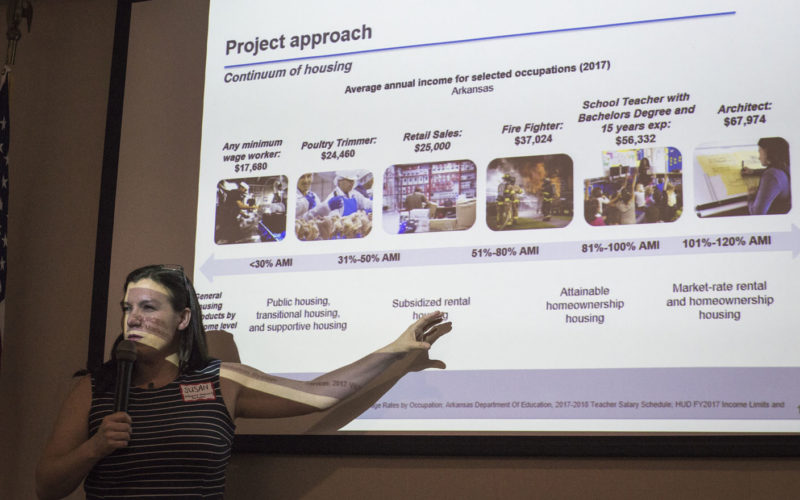Residents call for more affordable, connected, diverse housing
DAN HOLTMEYER
dholtmeyer@nwadg.com
Hundreds of Northwest Arkansas residents say they want the region to have more housing that’s affordable and accessible to all and stands near work, services and school.
They shared their perspectives at public forums earlier this month in the area’s four biggest cities, part of an ongoing study to take stock of Northwest Arkansas’ housing situation and develop recommendations to make sure there’s enough to go around in the future. The Walton Family Foundation, Northwest Arkansas Regional Planning Commission and other organizations plan to have the study finished by year’s end.

The Free Weekly/CHARLIE KAIJO
Jenjira Htoo of Springdale shares her point of view on how Korean-Americans are affected by a lack of housing in Springdale.
Participants included residents like Jorge Andrade, a Rogers homeowner who works at an architecture firm. He says he wants the area to avoid the fate of some coastal cities, where people can’t afford to live where they work and essentially live segregated by income.
“There’s a lot of gentrification happening in surrounding areas, mainly in Bentonville,” he said at the Rogers meeting June 6. “You need to have a balance.”
Northwest Arkansas has a reputation for its low cost of living, especially compared to major cities around the country. U.S. News and World Report, which ranked the region this year as the fifth best to live, found it was a better value than most metropolitan areas its size when comparing median income to median rent, which is about $750, and other housing expenses. Median rent in the No. 1 city — Austin, Texas— was about $1,100.
The region is nonetheless also experiencing an affordable housing shortage, says Susan Hartmann, program director for the nonprofit Enterprise Community Partners. The group is working on the study and led the forums.
There are enough apartments and homes for every household, but prices and lack of available units keep thousands of people stuck in housing that soaks up too much of their income, Hartmann told the crowds.
Census estimates show a majority of local households making less than $35,000 a year are considered cost-burdened, meaning they pay more than a third of their income on rent and utilities. For those making less than $20,000, such as a single adult with a minimum-wage job or on Social Security, the cost-burdened proportion surpasses 80 percent.

The Free Weekly/CHARLIE KAIJO
Springdale residents write down their reactions to statistics about the lack of affordable housing in Springdale June 7 during a community meeting at the Shiloh Museum in Springdale.
The region’s four large cities need about 2,000 more housing units affordable to households below the $20,000 income mark, Hartmann says. The shortage multiplies when factoring in lower-cost units taken by tenants who could afford costlier options. With this lack of availability, the cities need 7,000 more units with low rents to have enough for that income bracket.
The Northwest Arkansas Continuum of Care, a regional organization working to lower homelessness, received about $120,000 in donations and a state grant this spring to help several dozen homeless families with deposits and a few months’ rent. The organization’s been able to find apartments that are available and affordable for fewer than 10 families as of the middle of last week, Continuum board member Debbie Martin says.
“There’s just not a lot of available units in Northwest Arkansas,” she says. “Everything has to line up just perfectly.”
The money comes with an expiration date at the end of July, but Martin says the group won’t abandon any families in the program who aren’t housed by then. The Continuum connects multiple service organizations and shelters to get people experiencing homelessness the particular help they need to get housing.
“They’re working tirelessly at that, which is really exciting,” Martin says of those groups.
Such issues can be tricky to solve — it’s hardly unreasonable for people with higher incomes to choose lower-cost housing, Hartmann says. Some cities around the country try income restrictions on housing developments, for instance. Others try to encourage more housing construction of all kinds. Whatever direction Northwest Arkansas takes, it’s ahead of the curve compared to some other metropolitan areas, she says.

The Free Weekly/CHARLIE KAIJO
Susan Hartmann, program director at Enterprise Community Partners, gives a presentation June 7 showing the housing demographics in Springdale during a community meeting at the Shiloh Museum in Springdale. The University of Arkansas College of Business, Northwest Arkansas Regional Planning Commission, Walton Family Foundation and a nonprofit group called Enterprise Community Partners are taking stock of the housing and housing affordability in the area. They’ll be putting together a regional plan to try to make sure there’s enough housing affordable to everyone in coming years. They held public forums in four cities to get residents’ thoughts on where housing is lacking and what the regional plan will need to keep in mind.
“They wish that they had thought of affordability at the beginning,” Hartmann says. “It’s easier to tackle it up front.”
The more than 200 residents who attended the meetings included members of local nonprofit groups, city officials and developers.
They gave Enterprise plenty of factors to keep in mind as it puts together recommendations for tackling the issue. Many says housing must be safe in general and accessible for people with disabilities, for instance. Others pointed out criminal and financial history screens can block people from housing even if they could afford it. New housing should be close to cities’ centers to avoid high transportation costs, several added.
“There needs to be a way that all people can find a decent place to live and be able to afford it,” says Joyce Murray of Springdale, who’s retired and hopes to stay in her home for the rest of her life. She wants others to be able to do the same, but she says that’s only possible if cost of living holds steady and public transportation and other amenities are close by.






